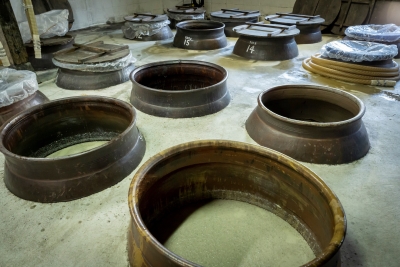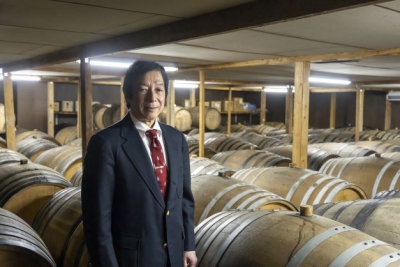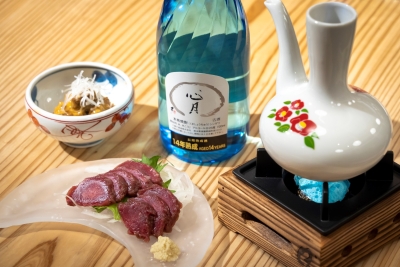Building a Future for Kuma Shochu through the Passion and Strategies of Local Distilleries Hitoyoshi Kuma

Kuma Shochu is one of the shochu brands designated as a Geographical Indication by the World Trade Organization. It is produced in the Hitoyoshi Kuma region, which is in a long, thin basin that stretches 40 km east to west and 10 km north to south in the southern part of Kumamoto Prefecture. The basin is surrounded by the Kyushu Mountains and through its center runs the Kumagawa River, one of the three fastest flowing rivers in Japan. Hitoyoshi Kuma has been called “Japan’s most vibrant hidden village.” Unusually, there are 27 different shochu distilleries centered in this one region. Each of these distilleries has carried forward the area’s more than 500-year-old rice shochu tradition, and today they continue to create unique shochu products that maximize their individual features and charms. During the Meiji period (1868–1912), Kuma Shochu was an extravagant drink that cost four times as much as sake. One of Kuma Shochu’s appeals is the hard work that distillery owners put in to raising the product’s value.
Unique Regional Characteristics
With the Kumagawa River and its tributaries, the Hitoyoshi Kuma region has an abundance of water resources. Further, with drastic temperature changes within the basin, the climate of the area is ideally suited to rice production. For over 700 years between the early Kamakura period (1185-1333) and the Meiji Restoration (1868-1889), the Hitoyoshi Kuma region was controlled by the Sagara clan who formed an array of unique cultures in the area. One of these was rice shochu, an industry that made the most of the area’s natural surroundings.
Kaori Kiyota, executive director of the Kuma Shochu Makers’ Association, tells us her thoughts on what makes Kuma Shochu so appealing:
“Rice shochu has a long history, with records as far back as 1559 featuring the word ‘shochu.’ It is thought to have first been produced in the Muromachi period around 500 years ago. Hitoyoshi Kuma has been designated a Japan Heritage and been described as Japan’s most vibrant hidden village. It is home to 27 different distilleries, who together produce more than 200 unique shochu brands. In this sense, it is a one of a kind. There are strong links between the distilleries, too, with each of the 27 establishments jointly investing in the launch of the Kuma Shochu Cooperative to promote joint sales of Kuma Shochu and ingredients, and to further develop each area of business. Through cooperation and competition, the distilleries have passed on their traditions to successive generations.
Widely Communicating the Appeals of Rice Shochu through Product Development from a Woman’s Perspective 【Sengetsu Shuzo】
Sengetsu Shuzo is a shochu distillery that was founded in 1903. The distillery has had a chief distiller in-house since its founding, and so proprietary techniques have been passed down through each generation. Junko Tsutsumi is the fourth-generation representative director of the distillery, and the second daughter of a member of the founding family. She joined Sengetsu Shuzo in 2002 after spending some time at an advertising agency in Fukuoka. Since assuming the role of representative director in 2016, she has engaged in product development using her unique woman’s perspective.
One product she developed to showcase the appeals of shochu to women and others who don’t drink shochu is “Koi Shisou”, a liqueur made from red shiso, or red perilla. Working alongside female researchers, Tsutsumi used locally produced red perilla to produce a stunning red liqueur that is free of colorings, flavorings, and preservatives. Koi Shisou was awarded the Grand Prize in the Liqueur Category at the 2022 Feminalise Global Wine Competition, which is judged exclusively by 600 women worldwide with expertise in the field. In 2021, the distillery launched “CRESCENT”, a craft gin that uses rice shochu as its base alongside nine botanicals including ginger, yuzu and amanatsu citrus, cypress, and tea from Kumamoto Prefecture. Precisely because it is adored in the local region, Sengetsu Shuzo aims to widely communicate the charms of rice shochu and the natural local environment, and is committed to using local ingredients for local consumption.
The distillery is also expanding its business overseas and currently exports its products to 14 countries. Tsutsumi and the distillery’s general sales manager travel together overseas to conduct sales activities. She says, “Instead of asking people to simply drink our products, we believe it is important to tell the products’ stories, be it where they were produced or what thoughts went into their production. Our popular Kawabe product, for example, is made using water from the Kawabe River, the only river to have been named by the Ministry of Land, Infrastructure and Transport as having the highest water quality in all of Japan for 16 consecutive years. Moreover, the rice we use in the product is grown in Sagara village using this water. The distillery itself is close to the river, too, and so Kawabe has been produced carefully using water drawn directly from the river. Through the product we are aiming to promote the appeals of the rich nature of the Hitoyoshi Kuma area.”
Elsewhere, as one of its novel initiatives Sengetsu has teamed up with MUJEN SPIRITS in Hollywood, Los Angeles, to jointly develop “MUJEN”, the first authentic rice shochu developed exclusively for sale in the US. Mujen is served in bars and restaurants in the US and is said to have gained a stellar reputation.
“People often say to me that it must be hard working in a male-centered industry, but the attention on me as a female distillery owner helps to promote our products, and so it’s actually working in my favor,” says a smiling Tsutsumi. We look forward to seeing what new charms she will create from Kuma Shochu and how she will communicate them.
[Sengetsu Shuzo website: https://sengetsu-shuzo.com/]
Creating Diverse Flavors Through an Age-old Technique Using Earthenware Pots 【Fukano Shuzo】
Founded during the Edo period in 1823, Fukano Shuzo is a long-standing shochu distillery. Previously, the shikomi process for rice shochu was undertaken in earthenware pots. However, there was a limit to the number that could be used for shochu production in one go, and temperature management was also a challenge. Although many distilleries switched to use of steel tanks for greater efficiency, Fukuno Shuzo continues to use earthenware pots to this day.
Seventh-generation representative director of the distillery Seiichi Fukano says, “As a distillery, we are particular about using earthenware pots in the shikomi process. Doing so creates a smoother taste. This is one production process that we will always keep.” When Fukano took over management, the company was having a hard time.
“When I was in the first year of university the company took a turn for the worse, and so I left my studies and took over. At the time, it was myself, my father, and our accountant. After preparing the shochu in the morning, we would head out on sales rounds, and return in the evening to bottle the products,” says Fukano. As Fukano desperately went about sales activities to promote the quality of shochu made in earthenware pots, an opportunity arose. It was around the time of the so-called second shochu boom, when consumption of shochu soared from Kyushu throughout the rest of Japan. Fukano was approached by the Japan Prestige Sake Association who wanted to commence sales of shochu produced in earthenware pots. As a result, nationwide expansion began. This was evidence that Fukano Shuzo’s methods had been recognized and accepted.
While growing his sales channels, Fukano went about creating new flavors using the qualities of the earthenware pots. He used a new koji mold that wasn’t being used for shochu at the time, fermenting the mixture at low temperature to create “Saiba”, a shochu with a wonderful aroma and fruity flavor. In 2000 and 2001 Saiba was recognized with the Monde Selection Gold Award. Another product he created was “Toki no Fuin”. Fukano aged the shochu for a long time in oak barrels, producing a drink with a high alcohol content (30%) in line with the preferences of customers in Europe and the US. Toki no Fuin won the Platinum Award in the Rice Shochu Category at the 2021 Kura Master Awards.
Fukano places importance on the fact that business grows through connections with local people. He is therefore proactively engaged in product development using local ingredients, be it vegetable shochu made from Hitoyoshi Kuma vegetables or chestnut shochu using chestnuts from the Yamae region in Kumamoto Prefecture.
Fukano, who is also managing director of the Kuma Shochu Makers’ Association, says, “Global recognition of rice shochu is still incredibly low. I look forward to working alongside others in the Hitoyoshi Kuma region to set up overseas strategies for Kuma Shochu.” Today the company is bursting with energy, with a new skilled chief distiller moving to the area from Shizuoka and an increase in number of young employees.
[Fukano Shuzo website: https://www.shop-fukano.jp/hpgen/HPB/entries/6.html]
Focusing Management Resources on long-term storage and aging Shochu to Raise the Value of Kuma Shochu 【Rokuchoshi Shuzo】
“Previously, rice shochu was an expensive drink that cost up to four times more than sake. My focus is on long-term storage and ageing because I want to bring this value back,” says Michihito Ikebe, representative director of Rokuchoshi Shuzo. Rokuchoshi Shuzo was founded in 1923. Ikebe has been representative director of the distillery since 1994 when he was 35 years old. Today, around 99% of the shochu produced at Rokuchoshi Shuzo is Choki-chozo Jukusei-shu( shochu that is stored and aged over long periods). That said, Rokuchoshi Shuzo did not initially specialize in this type of shochu. It was in the year 2000 that a major decision was made.
Ikebe says, “With the abolition of the Large-scale Retail Store Law, there was a huge increase in number of products from national mass retail stores, drug stores, and major manufacturers. As a result, local retailers closed down one after the other. As a small- to medium-sized manufacturer ourselves, we began to lose our sales space and faced a real crisis.” Ikebe thus looked carefully at different strategies that would enable the distillery to survive. He ultimately decided to focus on Choki-chozo Jukusei-shu, a variety that he himself loved and one that the distillery had been producing since its founding. “The charm of Choki-chozo Jukusei-shu lies in its sweet-smelling aroma and deep flavor. Further, as it takes seven years at the very least to produce, it cannot be mass produced and its rarity gives it a unique quality. I thought that this high quality and rarity would enable us to switch to a more profit-focused strategy,” says Ikebe. Ikebe stopped producing products with little future potential, put a stop to brands that weren’t in line with the new strategy, and boldly downsized the company. He then drove forward his profit-focused strategy together with department stores, high-end supermarkets, and local sake and shochu stores who understand the value of his products.
His products went on to win numerous awards at, for example, the Kura Master Awards, the Tokyo Whisky and Spirits Competition, and the Superior Taste Awards (ITI). Today, Rokuchoshi Shuzo has become synonymous with Choki-chozo Jukusei-shu, and it is now looking to further expand its business abroad. Although the distillery already exports to Singapore, Thailand, Canada, Germany, and Italy, Ikebe’s biggest priority for the future is the French market.
“To date, the biggest hurdle in negotiating with clients in Europe and the US has been the fact that they don’t drink distilled liquor at mealtimes. In 2022, however, I had the opportunity to seek advice from some sommeliers in France who suggested that I pursue the potential of shochu as a mealtime drink. While realizing that times had begun to change, I became very excited for what the future might hold,” says Ikebe.
Some of the bottle designs at Rokuchoshi Shuzo are designed by Keisuke Serizawa, previously named a living national treasure, and master painter Morikazu Kumagai. Ikebe sees shochu as a culture, and his bold endeavors are set to continue.
[Rokuchoshi Shuzo website: http://rokuchoshisyuzou.sakura.ne.jp/]
A Guide That Links Customers with Distilleries 【Kuma Shochu and Kuma Cuisine “Kai”】
Kai locates close to the national treasure Aoi Aso Shrine. It was established by Toshiaki Kuroki and his wife Makiko, both who were born in the Hitoyoshi Kuma region. Makiko is one of the Kuma Shochu guides designated by the Kuma Shochu Makers’ Association. There are more than 80 different varieties of Kuma Shochu from 28 distilleries, one of which have closed down. Among others, Makiko is responsible for carefully explaining the characteristics and personalities of each distiller, the distilling methods and flavor differences of each brand, and how to enjoy shochu using garachoku, a unique carafe and cup set especially for Kuma Shochu.
“I’m often asked what food pairs best with rice shochu, but because it’s made of rice it goes with almost anything. Kuma Shochu is delicious in whatever way it is consumed, be it on the rocks, with water, hot water, or soda water, or even hot. It’s great fun to try out these different styles, find your favorite brand, and discover different food combinations,” says Makiko.
Kai is a place where many locals and visitors from both Japan and abroad come to experience the food culture of Hitoyoshi Kuma. Visitors can enjoy an array of combinations, such as local game alongside shochu with the sweet flavors of rice and depth from the ageing process, and freshwater fish such as sweetfish and trout together with fragrant and fruity shochu.
[Kuma Shochu and Kuma Cuisine Kai website: http://kai-kuma.com/]












